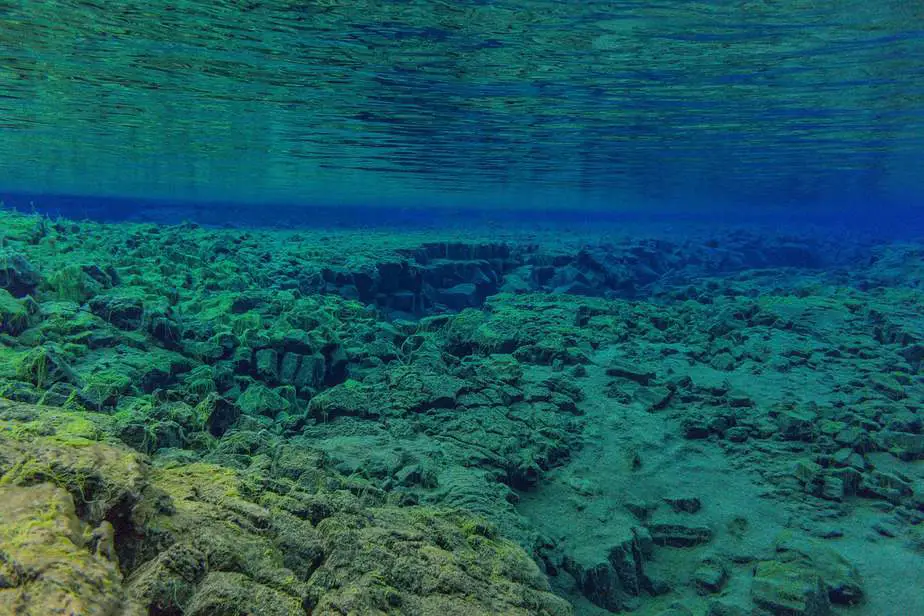Don’t hang up your scuba kit just because summer’s over. If you learn how to do cold water diving, you will be able to dive year round. Diving in the winter can be as fun as summer diving. However, it isn’t as easy and it has increased risks (namely hypothermia). But with the right training and equipment, you will be able to easily dive in water temperatures of 10°C (50°F) and below.
If you are a warm water diver who usually dives in a tropical destination, thinking of cold water diving might send a shiver down your spine. Don’t worry; you’re going to be wearing a drysuit instead of a wetsuit so you’ll stay dry and warm while diving in cold or temperate waters. Then you’ll be able to explore shipwrecks, walls covered in coral and anemone, kelp forests, and see lots of aquatic life that can only be found in cold waters. In this article, we’ll explore how you can get started with cold water diving.
What is cold water diving?
If you’re wondering what exactly cold water diving is, it’s when you are diving in near-freezing temperature water. It’s not quite the same as ice diving, which technically involves diving in cold waters, with the clear distinction that ice must be present in order for it to be ice diving. Any dive in water that is 14-17°C (57-65°F) or below is considered cold water diving.
At these temperatures, the water will not just be uncomfortably cold; they can be downright dangerous if you aren’t wearing the appropriate exposure suit. Wearing a high quality suit with multiple layers to protect your core as well as your extremities is critical for your safety. At these temperatures, you’ll either be wearing a 7mm+ thick wetsuit or wearing a drysuit.
You can also consider wearing a semi-dry suit which keeps your body dry during a dive. However, if you’re going to be spending hours in temperate or cold water, your body temperature is going to drop significantly unless you’re wearing a drysuit. If you’re just getting started with scuba diving, don’t start out with cold water dives because it can be very risky.
Cold water diving tips
Skill considerations
Warm water divers may not be used to the feel of wearing additional layers of clothes, however it’s something you’ll get used to very quickly. To make the transition smoother, we recommend easing into it. Don’t wait until it’s the dead of winter before trying out your new scuba gear. Start early enough in the season when the temperature is still manageable so you can adjust to your new kit in relative safety.
Another safety precaution you should take is to dive only in places you’ve already been before. This helps keep the task load at an acceptable level, allowing you to focus only on the new stuff without any distractions. If you’re diving with a thick wetsuit then not much is different; you’ll have to get used to the more restricted movement.
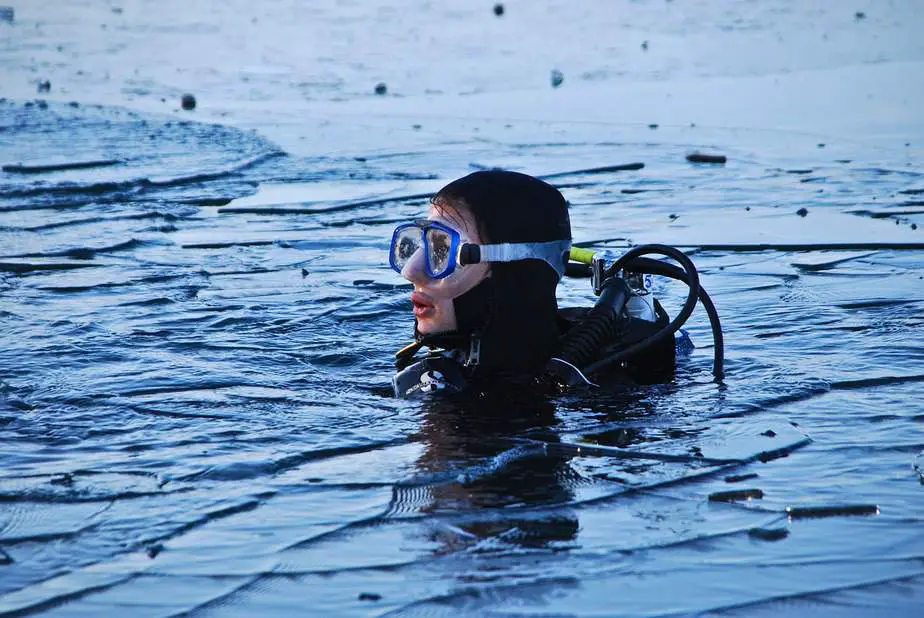
If you’re diving in a drysuit and are not used to it, you have a few options. Either take an actual Dry Suit Diver course, or get an experienced drysuit diver friend to show you the ropes or to accompany you so you can understand how a drysuit works. No, watching a few videos on YouTube or reading an article like this one is not an acceptable substitute.
Furthermore, depending on where you live, winter doesn’t just mean colder weather; it also means that it gets darker much faster. You’ll be losing 3-4 hours of daytime, and thus any dive beyond late afternoon will now become a night dive. Ideally, you should also be an experienced night diver, otherwise dealing with this new issue adds to the total task load.
Depending on where you live, the water might get cold enough to freeze. Once it reaches this point, you’re no longer just cold water diving; you’re ice diving. Ice diving is a great type of diving as well, however it’s much more advanced than cold water diving. Since ice diving occurs in an overhead environment, the risk increases even further, and you’ll need to take the Ice Diver course to receive the proper training.
Staying warm
To stay warm while cold water diving, whether you’re wearing a wetsuit or a drysuit, the key is to wear more layers. Just because the water temperatures have plummeted doesn’t mean your core body temperature has to.
Before you enter the water, make sure you start off warm. That means you need to put on your drysuit quickly so that you don’t lose too much body heat before you even start your dive. Otherwise, you’ll have to wait a bit to warm up before heading in. After a dive, you’ll want to do the same steps but in reverse.
A key tip to remember is don’t take off any of your cold water scuba gear (e.g., gloves, hood) until you’re ready to doff the whole kit and return to your regular clothes. Even just removing one article of clothing and leaving your skin exposed can cause plenty of body heat to escape.
Bring a fleece hat and gloves to keep yourself warm while wet. Fleece is optimal for two reasons: 1) it keeps your hands and head warm (most heat loss occurs through the head), and 2) it wicks cold water away and helps you dry faster.
Also bring a warm beverage, such as hot, sweetened tea or hot chocolate to get some energy into your body and warm you right up. The cold water saps a lot of energy from us, so replenishing glycogen and heat is a great strategy to recover.
Cold water diving gear
In this section, we will go over the scuba gear you need to dive in cold water. Thankfully, you can continue using most of the same gear that you would use when warm water diving. However, special consideration must be made for your regulator and exposure suit.
Mask for cold water diving
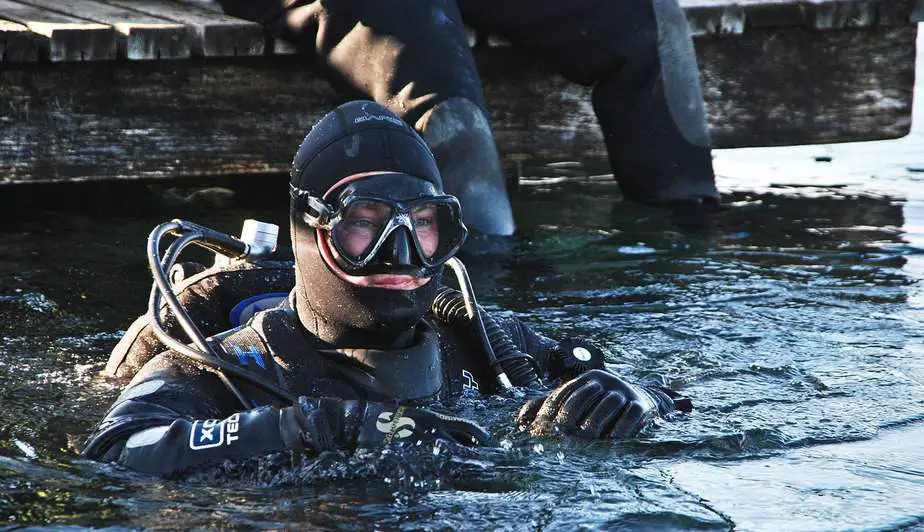
There is no need to buy a new mask for cold water diving. Whichever one you normally use is good enough. If you cannot stand the feeling of cold water touching your cheeks, you can try using a full face dive mask. Some people find full face dive masks to be uncomfortable and would rather brave the cold using their regular mask. Whatever the case, remember to spring a spare mask as well.
When diving in warm water, you may sometimes need to clear your mask if water leaks in. Thus, even a mask that leaks some water is still usable to some degree. However, when cold water diving, clearing your mask exposes your entire face to cold water which will feel unpleasant. Thus, your mask should seal tightly against your face so you do not have to expose your face to the cold.
Fins for cold water diving
Fins are a can of worms all of their own. Once again, you could just wear what you were wearing while warm water diving. However, our recommendation is to get a pair of fins that are suited for frog kicking. Frog kicking is a way to swim while minimizing how much sediment you kick up from the bottom. It’s helpful in the sea, but essential for diving in quarries and freshwater lakes.
The fin type and its flexibility depends on the BCD and exposure suit you plan on wearing, as well as your physical conditioning. Most divers will wear a 7mm wetsuit or a drysuit when cold water diving. Thus, you need a pair of fins to balance out the extra buoyancy for your feet.
Heavy-duty, full-rubber fins such as the ScubaPro Jet Sport Fins or the Hollis F2 work great for this environment. These fins are examples of fins that are heavy enough to be used with drysuits to provide you a means to perform powerful frog kicks.
If you’re not a fan of the extra weight, perhaps because you’re a wetsuit diver, then check out the Apeks RK3 which are one of the best travel and cold water diving fins due to how lightweight they are.
Which exposure suit for cold water diving?
As we mentioned, most of your warm water gear is also suitable for cold water diving. However, you will definitely need to get a warmer exposure suit, because your 3mm shorty isn’t going to cut it anymore. Cold water diving will require a 7mm wet or semi-dry suit or even a full-blown drysuit right away. Picking the right suit type is important, so which one should you pick?
Mostly, it comes down to personal preference. People have different standards for what is considered cold. For the purposes of this article, we are going to recommend when to wear what exposure suit based on exposure suit manufacturers and training agency recommendations. The following table can give you a rough idea of what exposure suit to use under what conditions.
| Water temperature | If you get cold easily | If you don’t get cold easily |
| More than 30°C (86 F) | 1 – 3 mm shorty | Rashguard |
| 28 – 30°C (80 – 85 F) | 3 mm shorty or full suit | 1 – 3 mm shorty |
| 25 – 27°C (78 – 80 F) | 3 -5 mm full suit | 3 mm shorty or wetsuit |
| 22 – 24°C (73 – 78 F) | 5 – 7 mm wet or semi-dry suit | 3 – 5 mm wetsuit |
| 18 – 21°C (66 – 72 F) | 7mm wetsuit or semi-dry | 5 – 7 mm wet or semi-drysuit |
| 14 – 17°C (57 – 65 F) | Drysuit | 7 mm wet or semi-dry suit + ice vest |
| 10 – 13°C (50 – 56 F) | Drysuit | 7 / 8 mm semi-dry suit + ice vest or drysuit |
| 7 – 9°C (44 – 49 F) | Drysuit + heating system | Drysuit |
| 6°C and below | Drysuit + heating system | Drysuit |
The water temperatures above and the recommended exposure suit are provided on the basis that you will feel comfortably warm under those conditions. If you start shivering or feel numbness in your limbs, that is a clear sign that you are losing too much heat. Leave as soon as possible! Furthermore, take this list with a grain of salt. Everybody is different and what might be cold for one person is acceptable for another. If in doubt, warmer is better.
Recommended equipment for below 20°C (68°F)
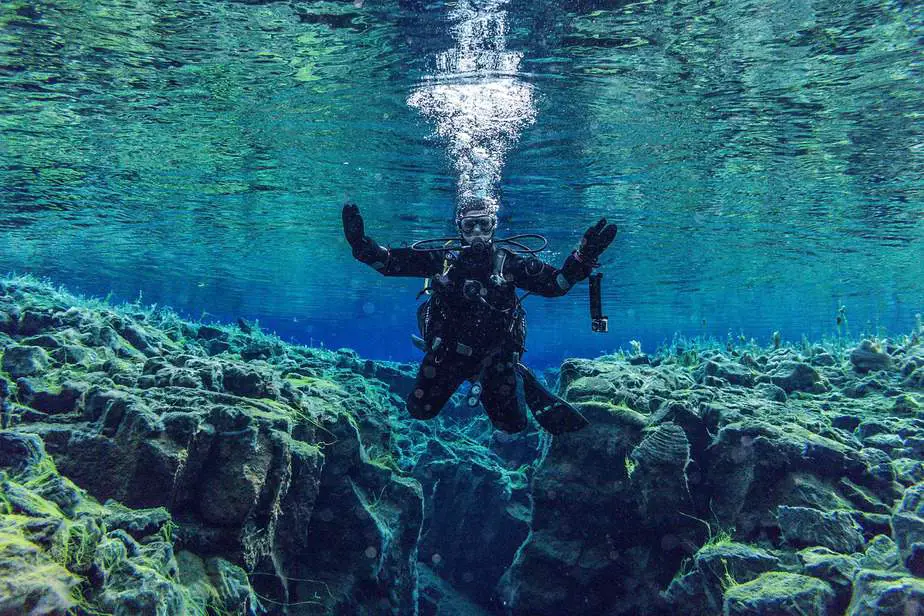
Looking at the table above, starting from a water temperature of 14-17°C (57-65°F), the average person should considering switching from a wetsuit to a drysuit. At this point, we can say that the water temperature has changed from temperate to cold. Divers who are more resistant to the cold may still be able to get by wearing a wetsuit.
If you still plan on wearing a wetsuit, we recommend the Aqua Lung SolAfx, which is arguably one of the best 7/8mm wetsuit for cold water diving. The fit is great and it should keep you warm for a long time. You can even wear an ice vest or a rashguard to add even more layers to your exposure suit.
The SolAfx is commonly used by scuba instructors who use cold water diving equipment year round. However, if you get cold easily, then perhaps you can try wearing a 7mm semi-dry suit for your cold water diving activities. A suit is “semi-dry” when it has extra cuffs woven in the arm and leg sleeves. This may seem like a marketing gimmick, however it does decrease water exchange in your suit which keeps your core body temperature higher.
The best semi-dry suit manufacturers nowadays are ScubaPro, Camaro, Bare, and Waterproof just to list a few. These wetsuits often come in both jumpsuit and hooded configurations.
Recommended equipment for below 10°C (50°F)
Once the water temperature starts reaching the low double digits (counting in celsius, here), you should make the switch from wetsuit to drysuit. At this point, unless you are literally Wim “The Iceman” Hof, you will almost certainly get hypothermia if you continue diving in a wetsuit.
A drysuit of any kind will keep you warmer than a wetsuit. Finding the right one is actually a lot easier than getting a wetsuit. Since a drysuit fits you quite loosely, unlike a wetsuit, you do not need to worry about getting the right fit. What matters the most in a drysuit is actually the undergarments you’ll be wearing underneath.
For the layers you’ll be wearing under a drysuit, we recommend puffy down coats. Vests are also a good option, as are wool layers. Basically, you want clothing that provides maximum warmth so you can stay snug and cozy while diving in near-freezing water.
Furthermore, a drysuit is a pretty significant investment, so unless you’re sure you plan on doing plenty of cold water diving, you should not get a drysuit. On the other hand, if you’re an avid cold water diver, you need to get one eventually.
If you are one of those people who somehow generates heat like a furnace and you never seem to be cold, you will still need to wear at least a 7mm wetsuit such as the SolAfx we recommended above. However, don’t expect to dive for very long in a wetsuit, since even the best wetsuit cannot keep your body temperature from dropping over time.
Personally, we know of people who have even used a wetsuit in 3°C (37°F) water for ice diving, however these people are like the aforementioned Iceman who seem to have a superhuman resistance to the cold. Do not try to imitate them.
Realistically, if you plan on diving in below 10°C (50°F) water, just wear a drysuit to be safe. Being in cold water is not just uncomfortable, but downright dangerous. When cold, you have an increased decompression sickness risk, and you’ll have to contend with the other dangerous effects of hypothermia.
Gloves, hood, and boots for cold water diving
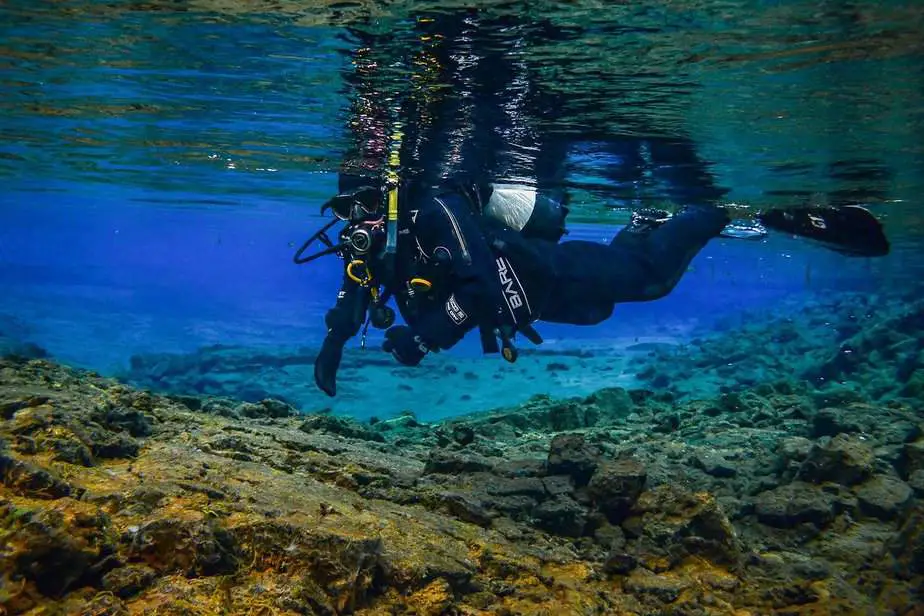
If you were primarily a warm water diver, you may not have had to wear gloves, boots, or a hood for cold water diving. For cold water diving, they are as much a necessity as a drysuit for protecting your most sensitive body parts from quickly losing heat. Compared to other scuba gear, these are relatively cheap.
For gloves, we recommend using at least 3-5mm thick gloves. Divers who have never worn gloves for diving, or wore very thin 1mm ones understandably might feel a little uncomfortable losing a bit of mobility and dexterity in their hands. However, you will feel so much warmer.
You can never be too warm, so 7mm gloves might be necessary depending on how cold the water is. There are different types of gloves, such as 5-finger gloves and 3-finger gloves, depending on how much dexterity you want. Practice using them before a dive, because you don’t want to be fumbling about in the cold for very long.
For dive boots, we suggest anything between 5-7mm thick if you’re not wearing a drysuit. We’ve had good experiences with the Aqua Lung 6.5mm dive boots, as well as the Cressi Tall 7mm boots. They aren’t the most robust boots out there, but they’ll keep you warm.
Lastly, most exposure suits come with an integrated hood. If your suit doesn’t have one, buy a hood right now. If it isn’t obvious by now, the thicker the better. For your dive hood, you may want to splurge a little bit for a good one. In case you’re not aware, the majority of heat loss actually occurs through your head. Also, literal brain freeze is a real thing, as anyone who has dipped their exposed head into ice-cold water can attest to. Make sure the hood fits snug without restricting circulation around your neck.
Cold water regulators
Aside from exposure suits, regulators were the second thing we mentioned divers needed to pay special attention to for cold water diving. Not all regulators are created equal, and most of them will literally freeze in cold waters.
We aren’t exaggerating; the first and second stages can actually freeze which can lead to a dangerous free-flowing situation. The water doesn’t even need to be at a freezing temperature. People who regularly dive in cold freshwater bodies of water, such as mountain lakes or quarries, can probably tell you of at least one such incident like this. You specifically need to use a cold water regulator to prevent this from ever happening.
If you normally dive in warm waters and never paid attention to your regulator, after finishing this article, have a look at the first stage on your regulator and read the engraving on the knob. If it reads EN250A, congratulations, you own a cold water regulator that can be used in water colder than 10°C (50°F). You don’t need to buy another one specifically for cold water diving.
In case you’re wondering what EN250A means, the “A” stands for annex which indicates that this model has been tested under cold water temperatures under the condition that you use one second stage per first stage. This part is important. You should only have one first stage (i.e. one valve in your tank) per second stage. Naturally, the second stage should also be EN250A compliant.
Our preferred cold water regulators are the Apeks XTX series, such as the XTX50, XTX100, or XTX200, or the ScubaPro Mk25. We review these models and more cold water regulators in another article.
Other cold water diving equipment
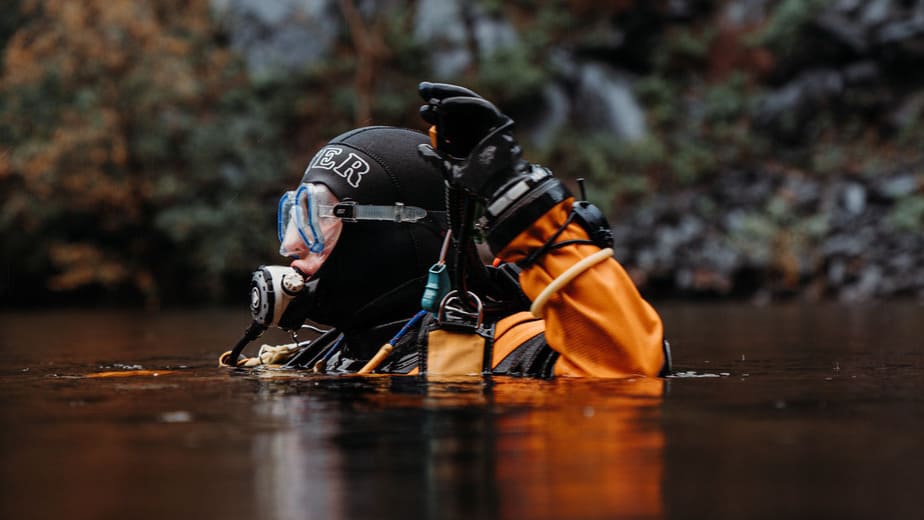
Other than your regulator and exposure suit, if you already own other equipment, they don’t need to be changed. Many cold water diving spots are freshwater and therefore require less dive weights to reach neutral buoyancy. However, using a thicker wetsuit or drysuit will negate this effect, possibly requiring you to use more dive weights than usual. As always, do a weight check whenever you swap out gear to know for sure.
A common question is whether you have to replace your dive computer for cold water diving. Dive computers should still work fine in cold water, so you don’t have to replace your Shearwater Teric. However, something to keep in mind is that lithium batteries won’t last as long in the cold. Thus, you should make sure to fully charge your dive computer so it won’t suddenly die on you during the dive. If you have a backup dive computer, remember to charge that as well.
Drysuit divers should consider wearing heating vests as an extra layer of thermal protection to keep you warm during the dive. As we mentioned, wool is a great option because it’s not only warm, but moisture wicking so it can help you dry out faster if you somehow get wet. Try out different layers of insulation underneath and find the ideal undergarments for you.
Surface equipment for cold water diving
Lastly, every dive begins with sufficient preparation long before you even set foot in water. Thus, you should be prepared even during the pre-dive. Bring water and stay hydrated even if it isn’t hot outside. Bring a hot beverage, such as hot chocolate or tea, which you can drink after a dive to warm up.
If you’re diving in a wetsuit, just before you head into the water, pour some warm (not boiling) water over your boots and gloves. Some of the warmth will remain even during the dive, keeping you warmer for just a little longer. However, some people overdo it and end up pouring scalding hot water on themselves. Do it at your own risk.
Bring additional warm clothes for after the dive because you’ll likely be a little cold even if you were using a dry suit. Make sure to dry your gear otherwise the water will quickly freeze.
No matter what type of diving you’re doing, a first aid kit and emergency oxygen should be available. In the case of cold water diving, also make sure you have warm blankets. If an accident occurred, you can wrap the individual in it to keep him or her warm until help arrives.
Parting words
If you have never dived in cold water before, know that it is an exciting way to experience a new underwater world. The aquatic life that you’ll find in cold water is different from what you’d find in tropical waters. Even though you can use a lot of the same gear from your warm water scuba kit, you have to get a cold water regulator as well as a 7mm wetsuit or a drysuit to be able to withstand the cold.
We discussed all of the necessary gear you need for cold water diving in the sections above. Sticking to these recommendations will help you stay warm while cold water diving. Furthermore, your gloves, boots, and hood should be thick enough for the water temperature you will be diving in. Generally, anything that is over 5mm thick is recommended. We highly recommend diving in a drysuit instead of a wetsuit.
As for your regulators, they must be EN250A compliant, and a redundant setup of two second stages as well as two first stages is necessary. At all stages of the dive: pre-dive, during the dive, and post-dive, you should try to keep your body temperature as high as possible. Bring warm clothes, blankets, and drinks in thermostats so you can quickly warm up. By following these tips, you can ensure everyone can get back home safely after an exciting cold water diving adventure.
Last update on 2025-06-16 / Affiliate links / Images from Amazon Product Advertising API

